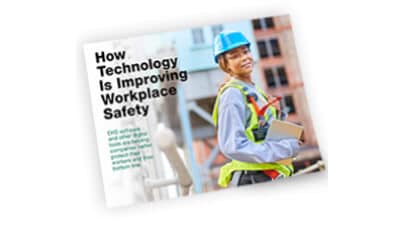Safe Workspaces: Innovations in Health and Safety Technology


Revolutionizing Workplaces: The Impact of Health and Safety Technology
In the contemporary landscape, the integration of health and safety technology is reshaping workplaces, prioritizing the well-being of employees and fostering a culture of safety. This article explores the innovative technologies making a significant impact on health and safety in workplaces.
IoT Sensors for Real-Time Monitoring
The Internet of Things (IoT) has become a cornerstone of health and safety technology. IoT sensors are employed for real-time monitoring of workplace environments. From tracking air quality to monitoring equipment conditions, these sensors provide valuable data to ensure a safe and healthy work atmosphere. This data-driven approach allows for proactive interventions in case of potential hazards.
Wearable Technology and Personal Safety Devices
Wearable technology has transitioned beyond fitness tracking to enhance workplace safety. Employees can utilize wearable devices equipped with sensors to monitor vital signs, detect fatigue, and even receive emergency alerts. These personal safety devices contribute to the overall well-being of workers by providing immediate assistance or notifying relevant parties in case of an emergency.
Augmented Reality (AR) for Training and Guidance
AR technology is revolutionizing safety training and guidance in workplaces. By overlaying digital information onto the physical environment, AR facilitates immersive training experiences. Employees can receive real-time guidance on using equipment, identifying safety hazards, and executing emergency procedures. This interactive approach enhances learning outcomes and ensures that employees are well-prepared for potential risks.
Drones for Safety Inspections and Surveillance
Drones have found applications in safety inspections and surveillance within industrial and construction settings. These aerial devices can access difficult-to-reach areas, conduct inspections, and monitor workplace conditions. Drones minimize the need for manual inspections in hazardous environments, reducing the risk to human safety while providing comprehensive data for preventive measures.
Biometric Access Control and Attendance Tracking
Biometric technology plays a vital role in ensuring secure access to workplaces and tracking attendance. Fingerprint recognition, facial recognition, and iris scanning provide a secure and efficient means of controlling access to restricted areas. Additionally, biometric attendance tracking eliminates the need for manual processes, enhancing accuracy and streamlining administrative tasks.
Occupational Health and Safety (OHS) Software
Occupational Health and Safety (OHS) software is a comprehensive solution for managing safety protocols in workplaces. These platforms streamline safety reporting, incident management, and compliance tracking. OHS software enables organizations to maintain a centralized database of safety information, ensuring that regulatory standards are met and facilitating a proactive approach to workplace safety.
Predictive Analytics for Safety Forecasting
Predictive analytics leverages historical data to forecast potential safety risks and trends. By analyzing past incidents and near-misses, organizations can identify patterns that may indicate future risks. This proactive approach allows businesses to implement preventive measures and interventions, reducing the likelihood of accidents and ensuring a safer working environment.
Robotics for Hazardous Tasks
Robotic technology is increasingly utilized for tasks that pose potential risks to human safety. In environments where exposure to hazardous substances or conditions is a concern, robots can perform tasks with precision and efficiency. This not only protects human workers from potential harm but also enhances overall workplace productivity.
Mobile Apps for Emergency Response
Mobile applications are instrumental in improving emergency response capabilities. Employees can use dedicated apps to report incidents, access emergency protocols, and communicate in real-time during crises. These apps enhance coordination among team members and emergency responders, ensuring a swift and organized response to unforeseen events.
Remote Monitoring and Telehealth Services
In the era of remote work, health and safety technology extends beyond the physical workplace. Remote monitoring and telehealth services provide employees with access to healthcare resources and wellness programs. This holistic approach ensures that health and safety considerations extend to both traditional workplaces and remote work settings.
Embracing a Safer Future
In conclusion, the integration of health and safety technology is transforming workplaces into safer and more secure environments. From real-time monitoring to predictive analytics, these innovations prioritize the well-being of employees and contribute to a culture of safety. To explore more about Health and Safety Technology for Workplaces, visit activolaboral.com and discover the latest advancements shaping the future of workplace safety.







